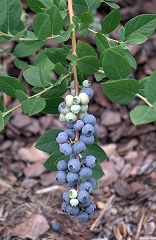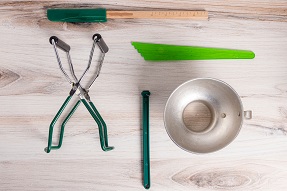I just love summer fruits. Fresh berries and cherries are the best. Summertime in America is when most of our berries are ripe and ready for picking.
What can you do with so many berries?
My favorite ways to preserve delicate summer fruit is by freezing them or canning berry jam. I like to preserve as much of my fresh harvest for later in the year as I can (pun intended). Jam may be canned or frozen. Naturally, freezing the jam bypasses the whole water-bath canning process.

Blueberry Jam Recipe
Ingredients:
6 1/2 cups mashed blueberries
4 1/2 cups sugar
2 tablespoons fresh lemon juice (preserves color and helps pectin gel)
1 box powdered pectin
Directions: Wash fruit, removing any stem pieces. Place berries in a flat-bottomed saucepot and mash with a potato masher. Measure exact amount of mashed fruit and place back into the large sauce pot. Add the lemon juice to the berries. Measure sugar and set aside. Place 1 box powdered pectin into a medium-size bowl. Add ¼ cup of the sugar to the pectin and stir. Add the pectin/sugar mixture to the fruit in the saucepot and stir. 1 teaspoon of butter may be added to reduce foaming. As the berries soften you can use an immersion blender to break up the berries if you want a smoother jam. Bring to a rolling boil (a boil that does not stop while stirring) over high heat, stirring constantly. Stir in remaining sugar and return to a rolling boil. Boil at rolling boil for exactly 1 minute.
At this point you may ladle into jars for Water-bath canning, or cool and freeze the jam in plastic freezer containers.
Canning: Immediately pour hot jam into hot, sterilized jars and cover jars with lids and rings, just to finger-tip-tight. Place filled jam jars into the water-bath canner filled to half-way with hot water. Once all the jars are in the water, add more water if needed to cover all the jars by at least one-inch of water above the lids. Bring to a boil. Continue to boil the jars in the water for 10 minutes for half-pint-size and smaller jars (4 oz. to 8 oz.), 15 minutes for larger jars.
What’s the difference between jam, jelly, and preserves?
- Jelly is made with the fruit juice only, and is usually transparent, like colored glass.
- Jam is made with the whole fruit- pulp, juice, and sometimes seeds and skins- and blended till almost completely smooth.
- Preserves can be transparent like jelly or smooth like jam and will have small pieces of fruit in them.
Canning fruit for Beginners
When learning how to can fruit, I have found that making jam is the simplest way to become familiar with the water-bath canning process. And of all the berries, I believe fresh blueberries to be the easiest fruits to work with for jam-making. There is no chopping, hulling, peeling or seed-straining necessary to can blueberry jam.
Getting started
Check out the USDA’s National Center for Home Food Preservation website. This is the Go-to place for information on how to safely can food at home. Read through your chosen recipe and the method several times to familiarize yourself with all that is involved. I recommend you have all your tools washed, sterilized and ready before you start processing the fruit.
Jam-making equipment:

- Water bath canner or any very deep pot with a lid
- Jar lifter
- Jars and lids
- Canning funnel
- Large ladle
- Large spoon
- Rubber spatula
- Potato masher or immersion blender (stick blender)
- Timer
- Pectin
- Lemon juice
- Fruit
- Sugar
Budget Options
My first water bath canner was a large stainless steel pasta pot, with lid, from a thrift store. When you are sterilizing and processing glass canning jars, they should not touch the bottom of the pot. That being said, into the pot I placed a collapsible vegetable steamer so the jars would not touch the bottom while heating. Jars can be reused from previous purchases if the 2-part canning lids will fit them. Or you may purchase used jars form thrift-stores or Facebook Marketplace. But be mindful: A case of 12 brand-new jars may be purchased for under $15, including lids and rings. Alternately, you may freeze your jam and skip the whole jar and canner process. However, since Florida is prone to summer power outages, I like to keep my freezers nearly empty during Hurricane Season.

What is Pectin?
Pectin is a natural soluble fiber substance found in many fruits and vegetables, such as apples and citrus. When heated to boiling, Pectin binds with the sugar, acid, and liquid in a mixture and holds them all together in a wobbly mass.
In our 2023 kitchens, we have many different pectin options. I find powdered pectin performs the best for me. Pectin can be purchased at most grocery stores, usually down the baking isle, or online. The brand I use is always sold in a double pack and has handy recipes inside for most of the common jam fruits. NOTE: if you want to make Mango Jam, use the recipe included for peaches and it works perfectly.
Getting Started
After making my first couple of batches of jam, I found a rhythm to the process and developed my own step by step system. These include:
- Begin by cleaning all surfaces and sinks
- Fill one sink 1-quarter full of hot, soapy water- add more hot water from the water-bath canner after jars are sterilized
- Fill water-bath canner and put it on the stove to boil.
- Pull out canning jars, lids, and rings to be sure I have enough of the same size jars to completely process the whole batch.
- Place the clean jars right in the canner with the water as it is coming to a boil to sanitize them
- Throw in my stainless-steel canning funnel just to be safe
- Sanitize lids, if reusing previous lids
- wash and measure the fruit
- measure the sugar, pectin/sugar, and lemon juice (if using)
I usually use a fresh box of lids each canning session so these do not need to be sterilized. Though, if reusing lids (not recommended), place these in a smaller pan of water to sanitize and boil them for 10 minutes. Jar rings may be reused till they rust. All this I do before I even measure and wash the fruit.
Happily, you can mix different berries for a “Mixed Berry Jam”. This spring I made a wonderful Blueberry-Mulberry jam that was a favorite around our house. Sadly, it did not make it to gift-giving season.
Jam-making Trivia:
There are several fruits which will not thicken into jam. These fruits include: pineapple, kiwi fruit, papaya, guava, figs, and fresh ginger (technically a rhizome). This is because of enzymes in the fruit which break down the proteins in the pectin and prevent gelling. This is true even for gelatin desserts made with these fruits.
And while you can make jam without commercial pectin, the process is quicker, the end-product so much better with the use of pectin. In my grandmother’s time, you either had to cook your sugared fruit mixture for long periods of time, stirring constantly over a hot stove, in summer, till it thickened or you had to have made your own pectin. Grandma made pectin at home from crabapples my Grandfather grew in his beautiful garden.

Gift of Jam
Homemade jams make excellent gifts for teachers, family, and friends. I like to make low-sugar berry jam recipes to be mindful of my family’s sugar intake. And I believe jam may be a healthier option than jelly because jam contains all the fiber of the fruit along with the flavor. Additionally, jam spreads more smoothly on toast and sandwiches.
Other uses for jam
- jam on pancakes
- cake filling
- fruit-flavored cream cheese
- in oatmeal
- to fill berry tarts or cookies
- over ice cream
To learn more about home canning, check out the National Center for Home Food Preservation website.
The “Ball Blue Book: Guide to Canning, Freezing, and Dehydrating”, is another go-to place for all canning related information. New and older versions are available wherever books are sold.
Your local library will have numerous books on home canning so be sure to look for these next time you visit.
 3
3
